Structure of NATO
The Structure of the North Atlantic Treaty Organisation is complex and multi-faceted.[1] The decision-making body is the North Atlantic Council (NAC), and the member state representatives also sit on the Defence Planning Committee (DPC) and the Nuclear Planning Group (NPG).[2] Below that the Secretary General of NATO directs the civilian International Staff, that is divided into administrative divisions, offices and other organizations. Also responsible to the NAC, DPC, and NPG are a host of committees that supervise the various NATO logistics and standardisation agencies.
The NATO Military Committee advises and assists the NAC on military matters. The Defence Planning Committee which directs its output to the Division of Defence Policy and Planning, a nominally civilian department that works closely with the Military Committee's International Military Staff.[3]
All agencies and organizations integrated into either the civilian administrative or military executive roles. For the most part they perform roles and functions that directly or indirectly support the security role of the alliance as a whole.
History
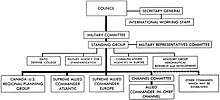
The Defence Planning Committee was a former senior decision-making body on matters relating to the integrated military structure of the Alliance. It was dissolved following a major committee review in June 2010 and its responsibilities absorbed by the North Atlantic Council.
Civilian structure
In NATO: The First Five Years Lord Ismay described the civilian structure as follows:[4]
The ..Office of the Secretary General [is] directed by an Executive Secretary, Captain R.D. Coleridge (UK), who is also Secretary to the Council. He is responsible for supervising the general processing of the work of the Council and their committees, including provision of all secretarial assistance, as well as supervision of the administrative services of the Staff/Secretariat itself. Thus the Secretariat provides secretaries to all the Council's principal committees and working groups - apart from those of a strictly technical nature - and ensures co-ordination between them. .. On the Staff side there are three main divisions corresponding to the three principal aspects of NATO's work, each under an Assistant Secretary General. Ambassador Sergio Fenoaltea (Italy) heads the Political Affairs Division, M. Rene Sergent (France) the Economics and Finance Division, and Mr. Lowell P. Weicker (USA) the Production and Logistics Division. The Divisions' tasks are to prepare, in close touch with delegations, proposed action in their respective fields for consideration by the appropriate committee or by the Council. In addition to the main divisions there are three other offices working directly to the Secretary General. These are the Office of Statistics (Mr. Loring Wood of the USA), the Financial Comptroller's Office (M. A. J. Bastin of Belgium), and the Division of Information (Mr. Geoffrey Parsons, Jr. of the USA). The Information Division, besides providing material about NATO for the use of member governments, (it does not engage in independent operations), is also the press and public relations branch of the civilian authority.
Military structure
The Strategic Commanders are the former 'Major NATO Commanders', who sat atop a command hierarchy consisting of Major Subordinate Commanders (MSCs), Principal Subordinate Commanders (PSCs) and Sub-PSCs.[5] The Military Committee had an executive body, the Standing Group, made up of representatives from France, the United States, and the United Kingdom. The Standing Group was abolished during the major reform of 1967 that resulted from France’s departure from the NATO Military Command Structure.[6]
Beginnings
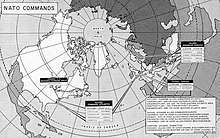
A key step in establishing the NATO Command Structure was the North Atlantic Council’s selection of General Dwight D. Eisenhower as the first Supreme Allied Commander Europe (SACEUR) in December 1950.[6] After Eisenhower arrived in Paris in January 1951, he and the other members of the multinational Supreme Headquarters Allied Powers Europe (SHAPE) Planning Group immediately began to devise a structure for the new Allied Command Europe. NATO official documents say '..The corner stone of the NATO Military Command Structure was laid.. when the North Atlantic Council approved D.C. 24/3 on 18 December 1951.'[7] They quickly decided to divide Allied Command Europe into three regions: Allied Forces Northern Europe, containing Scandinavia, the North Sea and the Baltic; Allied Forces Central Europe, and Allied Forces Southern Europe (AFSOUTH), covering Italy and the Mediterranean. SHAPE was established at Rocquencourt, west of Paris.
The British post of Commander in Chief Mediterranean Fleet was given a dual-hatted role as NATO Commander in Chief of Allied Forces Mediterranean in charge of all forces assigned to NATO in the Mediterranean Area. The British made strong representations in discussions regarding the Mediterranean NATO command structure, wishing to retain their direction of NATO naval command in the Mediterranean to protect their sea lines of communication running through the Mediterranean to the Middle East and Far East.[8]
In 1952, after Greece and Turkey joined the Alliance,[9] Allied Land Forces South-Eastern Europe (LANDSOUTHEAST) was created in Izmir, Turkey, under a U.S. Army General. This was due to the two states' geographic distance from the LANDSOUTH headquarters, as well as political disagreements over which nation should be the overall commander for their ground forces.
With the establishment of Allied Command Atlantic (ACLANT) on 30 January 1952, the Supreme Allied Commander Atlantic joined the previously created Supreme Allied Commander Europe as one of the alliance’s two Major NATO Commanders.[10] A third was added when Allied Command Channel was established on 21 February 1952 to control the English Channel and North Sea area and deny it to the enemy, and protect the sea lanes of communication.[11][12] The establishment of this post, and the agreement that it was to be filled by the British Commander-in-Chief, Portsmouth, was part of the compromise that allowed an American officer to take up the SACLANT post. Previously Commander-in-Chief Portsmouth had controlled multinational naval operations in the area under WUDO auspices. In due course the CINCHAN role was assumed by the British Commander-in-Chief Fleet.
In 1966, when French president Charles de Gaulle withdrew French forces from the military command structure, NATO's headquarters was forced to move to Belgium. SHAPE was moved to Casteau, north of the Belgian city of Mons. Headquarters Allied Forces Central Europe was moved from the Chateau de Fontainebleau outside Paris to Brunssum, in the Netherlands.
Structure in 1989
- NATO Military Committee, led by the Chairman of the NATO Military Committee, in Brussels, Belgium
- Allied Command Europe (ACE), led by Supreme Allied Commander Europe (SACEUR), in Mons, Belgium
- ACE Mobile Force, in Seckenheim, Germany
- United Kingdom Air Forces, in High Wycombe, United Kingdom
- NATO Airborne Early Warning Force, in Maisieres, Belgium
- Allied Forces Northern Europe (AFNORTH), in Kolsås, Norway
- Allied Forces North Norway (NON), in Bodø, Norway
- Allied Forces South Norway (SONOR), in Stavanger, Norway
- Allied Forces Baltic Approaches (BALTAP), in Karup, Denmark
- Allied Forces Central Europe (AFCENT), in Brunssum, Netherlands
- Northern Army Group (NORTHAG), in Rheindahlen, West Germany
- Central Army Group (CENTAG), in Heidelberg, West Germany
- Allied Air Forces Central Europe (AAFCE), in Ramstein, West Germany
- Second Allied Tactical Air Force (2 ATAF), in Rheindahlen, West Germany
- Fourth Allied Tactical Air Force (4 ATAF), in Ramstein, West Germany
- Allied Forces Southern Europe (AFSOUTH), in Naples, Italy
- Allied Land Forces Southern Europe (LANDSOUTH), in Verona, Italy
- Allied Land Forces South-Eastern Europe (LANDSOUTHEAST), in İzmir, Turkey
- Allied Air Forces Southern Europe (AIRSOUTH), in Naples, Italy
- Fifth Allied Tactical Air Force (5 ATAF), in Vicenza, Italy
- Sixth Allied Tactical Air Force (6 ATAF), in İzmir, Turkey
- Allied Naval Forces Southern Europe (NAVSOUTH), in Naples, Italy
- Naval Striking and Support Forces Southern Europe (STRIKFORSOUTH), afloat, centered around US Sixth Fleet
- Allied Command Atlantic (ACLANT), led by Supreme Allied Commander Atlantic (SACLANT), in Norfolk, United States[13]
- Eastern Atlantic Area (EASTLANT), in Northwood, United Kingdom
- Northern Sub-Area (NORLANT), in Rosyth, United Kingdom
- Central Sub-Area (CENTLANT), in Plymouth, United Kingdom
- Submarine Force Eastern Atlantic (SUBEASTLANT), in Gosport, United Kingdom
- Maritime Air Eastern Atlantic (MAIREASTLANT), in Northwood, United Kingdom
- Maritime Air Northern Sub-Area (MAIRNORLANT), in Rosyth, United Kingdom
- Maritime Air Central Sub-Area (MAIRCENTLANT), in Plymouth, United Kingdom
- Island Command Iceland (ISCOMICELAND), in Keflavík, Iceland
- Island Command Faroes (ISCOMFAROES), in Tórshavn, Faroe Islands
- Western Atlantic Area (WESTLANT), in Norfolk, United States
- Ocean Sub-Area (OCEANLANT), in Norfolk, United States
- Canadian Atlantic Sub-Area (CANLANT), in Halifax, Canada
- Island Command Bermuda (ISCOMBERMUDA), in Hamilton, Bermuda
- Island Command Azores (ISCOMAZORES), in Ponta Delgada, Azores
- Island Command Greenland (ISCOMGREENLAND), in Grønnedal, Greenland
- Submarine Force Western Atlantic (SUBWESTLANT), in Norfolk, United States
- Iberian Atlantic Area (IBERLANT), in Oeiras, Portugal
- Striking Fleet Atlantic (STRIKFLTLANT), in Norfolk, United States
- Carrier Striking Force (CARSTRIKFOR), in Norfolk, United States
- Carrier Striking Group One (CARSTRIKGRUONE), in Norfolk, United States
- Carrier Striking Group Two (CARSTRIKGRUTWO), in Plymouth, United Kingdom
- Carrier Striking Force (CARSTRIKFOR), in Norfolk, United States
- Submarines Allied Command Atlantic (SUBACLANT), in Norfolk, United States
- Eastern Atlantic Area (EASTLANT), in Northwood, United Kingdom
- Allied Command Channel (ACCHAN), in Northwood, United Kingdom
- Nore Sub-Area Channel Command (NORECHAN), in Rosyth, United Kingdom
- Plymouth Sub-Area Channel Command (PLYMCHAN), in Plymouth, United Kingdom
- Benelux Sub-Area Channel Command (BENECHAN), in Den Helder, Netherlands
- Allied Maritime Air Force Channel (MAIRCHAN), in Northwood, United Kingdom
- Maritime Air Nore Sub-Area Channel Command (MAIRNORECHAN), in Rosyth, United Kingdom
- Maritime Air Plymouth Sub-Area Channel Command (MAIRPLYMCHAN), in Plymouth, United Kingdom
- Standing Naval Force Channel (STANAVFORCHAN), afloat
- Allied Command Europe (ACE), led by Supreme Allied Commander Europe (SACEUR), in Mons, Belgium
After the Cold War
By June 1991, it was clear that Allied Forces Central Europe (a Major Subordinate Command) could be reduced, with the Soviet threat disappearing. Six multinational corps were to replace the previous eight.[14] Announcements in June 1991 presaged main defensive forces consisting of six multinational corps. Two were to be under German command, one with a U.S. division, one under Belgian command with a pending offer of a U.S. brigade, one under U.S. command with a German division, one under joint German-Danish command (LANDJUT), and one under Dutch command. The new German IV Corps was to be stationed in Eastern Germany, and was not to be associated with the NATO structure.
On July 1, 1994, the Alliance disestablished Allied Command Channel, through retaining many of its subordinate structures after reshuffling. Most of the headquarters were absorbed within ACE, particularly within the new Allied Forces Northwestern Europe.[15]
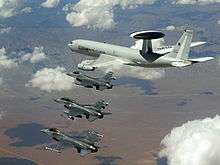
From 1994 to 1999 ACE had three Major Subordinate Commands, AFNORTHWEST, AFCENT, and AFSOUTH. In 1995 NATO began a Long Term Study to examine post-Cold War strategy and structure. Recommendations from the study for a new, streamlined structure emerged in 1996.[16] The European and Atlantic commands were to be retained, but the number of major commands in Europe was to be cut from three to two, Regional Command North Europe and Regional Command South Europe. Activation of the new RC SOUTH occurred in September 1999, and in March 2000 Headquarters AFNORTHWEST closed and the new RC NORTH was activated.[17] The headquarters of the two Regional Commands were known as Regional Headquarters South (RHQ South) and RHQ NORTH respectively. Each was to supervise air, naval, and land commands for their region as well as a number of Joint Subregional Commands (JSRCs). Among the new JSRCs was Joint Headquarters Southwest, which was activated in Madrid in September 1999.
Organizations and agencies
Prior to the reorganization, the NATO website listed 43 different agencies and organizations and five project committees/offices as of 15 May 2008.[18] They included:
- Logistics committees, organisations and agencies, including:
- NATO Maintenance and Supply Agency
- Central Europe Pipeline System
- NATO Pipeline System
- Production Logistics organisations, agencies and offices including the NATO Eurofighter and Tornado Management Agency
- Standardisation organisation, committee, office and agency including the NATO Standardization Agency which also plays an important role in the global arena of standards determination.
- Civil Emergency Planning committees and centre
- Air Traffic Management and Air Defence committees, working groups organisation and centre including the:
- NATO ACCS Management Agency (NACMA), based in Brussels, manages around a hundred persons in charge of the Air Control and Command System (ACCS) due for 2009.
- NATO Programming Centre
- The NATO Airborne Early Warning and Control Programme Management Organisation (NAPMO)
- NATO Consultation, Command and Control Organisation (NC3O)
- NATO Consultation, Command and Control Agency (NC3A),[19] reporting to the NATO Consultation, Command and Control Organization (NC3O). This agency was formed when the SHAPE Technical Centre (STC) in The Hague (Netherlands) merged in 1996 with the NATO Communications and Information Systems Operating and Support Agency (NACISA) based in Brussels (Belgium). The agency comprises around 650 staff, of which around 400 are located in The Hague and 250 in Brussels.
- NATO Communications and Information Systems Services Agency (NCSA), based in Mons (BEL), was established in August 2004 from the former NATO Communications and Information Systems Operating and Support Agency (NACISA).[20]
- NATO Headquarters C3 Staff (NHQC3S), which supports the North Atlantic Council, Military Committee, International Staff, and the International Military Staff.
- NATO Electronic Warfare Advisory Committee (NEWAC)
- Military Committee Meteorological Group (MCMG)
- The Military Oceanography Group (MILOC)
- NATO Research and Technology Organisation (RTO),[21]
- Education and Training college, schools and group
- Project Steering Committees and Project Offices, including:
- Alliance Ground Surveillance Capability Provisional Project Office (AGS/PPO)
- Battlefield Information Collection and Exploitation System (BICES)
- NATO Continuous Acquisition and Life Cycle Support Office (CALS)
- NATO FORACS Office
- Munitions Safety Information Analysis Center (MSIAC)
- Committee of Chiefs of Military Medical Services in NATO (COMEDS)
Civilian structure today
In the twenty-first century NATO has an extensive civilian structure, including:
- Public Diplomacy Division
- NATO Office of Security (NOS)
- Executive Management
- Division of Political Affairs and Security Policy
- Division of Operations
- Division of Defence Policy and Planning
- Division of Defence Investment
- NATO Office of Resources (NOR)
- NATO Headquarters Consultation, Command and Control Staff (NHQC3S)
- Office of the Financial Controller (FinCon)
- Office of the Chairman of the Senior Resource Board (SRB)
- Office of the Chairman of the Civil and Military Budget Committees (CBC/MBC))
- International Board of Auditors for NATO (IBAN)
- NATO Production and Logistics Organizations (NPLO)
The Defence Planning Committee (DPC) is normally composed of Permanent Representatives, but meets at the level of Defence Ministers at least twice a year. It deals with most defence matters and subjects related to collective defence planning. In this it serves as a coordinating body between the Civilian and Military organizational bureaucracies of NATO.
The Defence Planning Committee was a former senior decision-making body on matters relating to the integrated military structure of the Alliance. It was dissolved following a major committee review in June 2010 and its responsibilities absorbed by the North Atlantic Council.
Military command structure
The NATO Military Command Structure consists of two strategic commands directed by the North Atlantic Council:[22]
- Liaison: Provides advice and support to the NAC
| Political strategic level: | |||||||||||||||||||
| NATO SG (NAC) Brussels, BE | IS Brussels, BE | ||||||||||||||||||
| Military strategic level: | |||||||||||||||||||
CMC (NATO MC) | |||||||||||||||||||
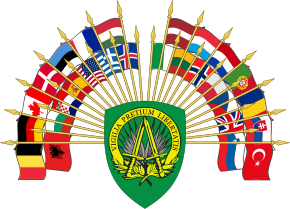 SACEUR (ACO, SHAPE) Mons, BE | 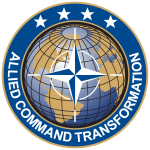 SACT (ACT, HQ SACT) Norfolk, US | ||||||||||||||||||
| Operational level: | |||||||||||||||||||
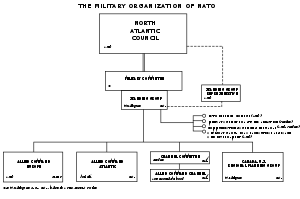
NATO's military operations are directed by the Chairman of the NATO Military Committee and split into two Strategic Commands, both long commanded by U.S. officers, assisted by a staff drawn from across NATO. The Strategic Commanders are responsible to the NATO Military Committee for the overall direction and conduct of all Alliance military matters within their areas of command.
On 12 June 2003 NATO ministers announced an end to the decades-old structure of a command each for the Atlantic and Europe. Allied Command Operations (ACO) was to be established, responsible for the strategic, operational and tactical management of combat and combat support forces of the NATO members, and Allied Command Transformation (ACT) responsible for the induction of the new member states' forces into NATO, and NATO forces' research and training capability.[23] The European allies had become concerned about the possibility of a loosening of U.S. ties to NATO if there were no longer any U.S.-led NATO HQ in the United States, and the refocusing of the Atlantic command into a transformation command was the result.[24] The alliance created several NATO Rapid Deployable Corps and naval High Readiness Forces (HRFs), which all report to Allied Command Operations. In Europe the Regional Commands were replaced by JFC Brunssum and JFC Naples, and the JSRCs disappeared (though the Madrid JSRC became a land command for JFC Naples).
The commander of Allied Command Operations retained the title "Supreme Allied Commander Europe", and remains based at SHAPE at Casteau. He is a U.S. four-star general or admiral with the dual-hatted role of heading United States European Command. ACO includes Joint Force Command Brunssum in the Netherlands, Joint Force Command Naples in Italy, and Joint Command Lisbon in Portugal, all multi-national headquarters with many nations represented.[25] From 2003, JFC Brunssum had its land component, Allied Land Component Command Headquarters Heidelberg at Heidelberg, Germany, its air component, Allied Air Command Ramstein, at Ramstein in Germany, and its naval component at the Northwood Headquarters in the northwest suburbs of London. JFC Naples has its land component in Madrid, air component at İzmir, Turkey, and its naval component, Allied Maritime Command Naples, in Naples, Italy. It also directed KFOR in Kosovo. Joint Command Lisbon was a smaller HQ with no subordinate commands.
In 2012-2013, the Military Command Structure was reorganised. Allied Force Command Madrid was disestablished on 1 July 2013, the Heidelberg force command also deactivated,[26] the maritime component command at Naples was closed[27] and the air component command at Izmir also shut down.[28] Allied Air Command Izmir was reorganised as Allied Land Command.
A number of NATO Force Structure formations, such as the NATO Rapid Deployable Corps, are answerable ultimately to SACEUR either directly or through the component commands. Directly responsible to SACEUR is the NATO Airborne Early Warning Force at NATO Air Base Geilenkirchen in Germany where a jointly funded fleet of E-3 Sentry AWACS airborne radar aircraft is located. The Boeing C-17 Globemaster IIIs of the Strategic Airlift Capability, which became fully operational in July 2009, are based at Pápa airfield in Hungary.
Allied Command Transformation (ACT) is based in the former Allied Command Atlantic headquarters in Norfolk, Virginia, United States. It is headed by the Supreme Allied Commander Transformation (SACT), a French officer. There is also an ACT command element located at SHAPE in Mons, Belgium. In June 2009 Le Figaro named the French officer who was to take command of ACT following France's return to the NATO Military Command Structure.[29] Subordinate ACT organizations include the Joint Warfare Centre (JWC) located in Stavanger, Norway (in the same site as the former Norwegian Armed Forces National Joint HQ); the Joint Force Training Centre (JFTC) in Bydgoszcz, Poland; and the Joint Analysis and Lessons Learned Centre (JALLC) in Monsanto, Portugal. The NATO Undersea Research Centre (NURC) at La Spezia, Italy, was also part of ACT until it was shifted under the auspices of the NATO Science & Technology Organization.
In early 2015, in the wake of the War in Donbass, meetings of NATO ministers decided that Multinational Corps Northeast would be augmented so as to develop greater capabilities, to, if thought necessary, prepare to defend the Baltic States, and that a new Multinational Division Southeast would be established in Romania. Six NATO Force Integration Units would also be established to coordinate preparations for defence of new Eastern members of NATO.[30]
Multinational Division Southeast was activated on 1 December 2015.[31] Headquarters Multinational Division South – East (HQ MND-SE) is a North Atlantic Council (NAC) activated NATO military body under operational command (OPCOM) of Supreme Allied Commander Europe (SACEUR) which may be employed and deployed in peacetime, crisis and operations.
On 25 April 2017, the commander-designate of the new Multinational Division Northeast arrived at the headquarters location at Elblag, Poland. On 3 July 2017, the new division reached initial operational capability (IOC).[32] The division is tasked to coordinate the four NATO Enhanced Forward Presence battlegroups and to carry out Article 5 collective defence activities.[33]
In late 2017-early 2018, two new commands were approved, a rear area transit command which was finally announced as the Joint Support and Enabling Command, to be located at Ulm, Germany, and a new command for the Atlantic.[34] In March 2018 Chair of the Military Committee General Petr Pavel announced that the new Atlantic command would become part of the NATO Force Structure at the level of a Joint Force Command, similar to the two that exist at Brunssum and Naples. On 7 June 2018 the Secretary-General said a new JFC will have its headquarters in Norfolk, Virginia, in the United States.[35] The name was confirmed as Joint Force Command Norfolk at the NATO Summit in July. It will be commanded by the Vice Admiral who leads the United States Second Fleet.[36]
Canada-US Regional Planning Group
The Canada-US Regional Planning Group (CUSRPG) is the only survivor of the originally five regional planning groups of the late 1940s and early 1950s.[37] All the others were subsumed into Allied Command Europe and Allied Command Atlantic.[38] In August 1953 it was tasked to '..(a) Prepare, approve and forward to the Military Committee, through the Standing Group, plans for and other material pertaining to, the defense of the Canada-U.S. Region. (b) Coordinate plans with SACLANT and other NATO Commands.[39] The NATO Handbook stated in 1990s editions that it was responsible for the defence of the US-Canada area and meets alternatively in Washington, D.C. and Ottawa. As such it appears to duplicate, in part, the work of the Permanent Joint Board on Defence.
NATO Networks
There are several communications networks used by NATO to support its exercises and operations:
- Battlefield Information Collection and Exploitation Systems (BICES)
- Crisis Response Operations in NATO Operating Systems (CRONOS), which is a system of interconnected computer networks used by NATO to transmit classified information at the level of NATO Secret.
- Combined Federated Battle Laboratories Network (CFBLNet), which is a wide area network connecting the US, the UK, Canada, Australia, New Zealand, six NATO countries and Sweden for sharing research and development information.
Organizations and agencies
A major reorganization of the NATO Agencies was agreed at a meeting of the defence ministers from NATO's 28 member states on 8 June 2011. The new Agencies' structure will build upon the existing one:[40]
- Headquarters for the NATO Support Agency will be in Capellen Luxembourg (site of the current NATO Maintenance and Supply Agency – NAMSA).
- The NATO Communications and Information Agency Headquarters will be in Brussels, as will the very small staff which will design the new NATO Procurement Agency.
- A new NATO Science and Technology (S&T) Organization will be created before July 2012, consisting of Chief Scientist, a Programme Office for Collaborative S&T, and the NATO Undersea Research Centre (NURC).
- The current NATO Standardization Agency will continue and be subject to review by Spring 2014.
References
- "NATO WEBSITE". Archived from the original on 22 December 2015.
- "NATO Handbook. 50th Anniversary Edition". NATO. p. 234. Archived from the original on 5 April 2017. Retrieved 4 April 2017.
- NATO's Military Committee: focused on operations, capabilities and cooperation
- "Chapter 6 - The civilian structure". NATO the first five years 1949-1954. NATO. Archived from the original on 15 March 2017. Retrieved 3 January 2008.
- T.D. Young, Reforming NATO's Military Structures, 7.
- Dr Gregory W. Pedlow, Evolution of NATO's Command Structure 1951-2009 Archived 1 March 2013 at the Wayback Machine.
- "SUMMARY OF THE NATO MILITARY COMMAND STRUCTURE, TERMS OF REFERENCES AND AREAS OF RESPONSIBILITY OF THE MAJOR NATO COMMANDERS' AND THEIR IMMEDIATE SUBORDINATE COMMANDERS". Archived from the original on 5 April 2017. Retrieved 4 April 2017.
- Sean Maloney, 'To Secure Command of the Sea,' University of New Brunswick thesis, 1991, p.258-261
- "Chapter 7 - The Military Structure". NATO the first five years 1949-1954. NATO. Archived from the original on 15 March 2017. Retrieved 3 January 2008.
- "Chapter 7 - The Military Structure - Atlantic Command". NATO the first five years 1949-1954. NATO. Archived from the original on 15 March 2017. Retrieved 3 January 2008.
- "Chapter 7 - The Military Structure - Channel Command and Channel Committee". NATO the first five years 1949-1954. NATO. Archived from the original on 10 January 2008. Retrieved 3 September 2008.
- "NATO the first five years 1949-1954". NATO. Archived from the original on 15 March 2017. Retrieved 4 April 2017.
- "Revised Terms of Reference for SACLANT" (PDF). NATO Archives. NATO Standing Committee. Archived (PDF) from the original on 2 December 2017. Retrieved 26 September 2016.
- Barbara Starr, 'Cold War Battle Orders Make Way for a New NATO Era,' Jane's Defence Weekly, 8 June 1991.
- Thomas-Durrell Young, Command in NATO After the Cold War: Alliance, National, and Multinational Considerations Archived 20 February 2015 at the Wayback Machine, U.S. Army Strategic Studies Institute, June 1, 1997, 11, citing JDW July 17, 1993.
- Pedlow, 12.
- T.D. Young, 'NATO After 2000,' 16-18.
- NATO, Organizations and Agencies Archived 15 April 2011 at the Wayback Machine, accessed May 2008
- "Service Desk". www.nc3a.nato.int. Archived from the original on 14 January 2009. Retrieved 14 May 2019.
- NATO Communication and Information Systems Agency Archived 2008-04-21 at the Wayback Machine
- "NATO Research & Technology Organization". Archived from the original on 28 February 2009. Retrieved 14 May 2019.
- "Command Structure" (PDF). NATO. Retrieved 19 October 2019. and "Military Command Structure". shape.nato.int. Supreme Head Allied Powers Europe. 12 February 2020. Retrieved 12 February 2020.
- Espen Barth, Eide; Frédéric Bozo (Spring 2005). "Should NATO play a more political role?". Nato Review. NATO. Archived from the original on 12 July 2007. Retrieved 15 July 2007.
- Pedlow, 13-14.
- Allied Command Operations, Military Command Structure Archived 20 February 2015 at the Wayback Machine
- Vandiver, John (30 November 2012). "NATO Activates Allied Land Command". Stars and Stripes. Archived from the original on 5 February 2013. Retrieved 2 February 2013.
- "Deactivation ceremony of Allied Maritime Command Naples". Headquarters Allied Joint Force Command Naples. Archived from the original on 14 July 2014. Retrieved 16 April 2013.
- "NATO deactivates allied air command Izmir headquarters Turkey". NATO. Archived from the original on 14 July 2014. Retrieved 16 April 2013.
- (in French) LeFigaro.fr Archived 13 June 2009 at the Wayback Machine, accessed June 2009
- BBC, NATO Readjusts as Ukraine Crisis Looms Archived 22 July 2018 at the Wayback Machine, 5 February 2015.
- "NATO Activates New Multinational Division Southeast Headquarters in Bucharest, Romania". NATO Headquarters, Belgium. 1 December 2015. Archived from the original on 19 March 2017. Retrieved 26 May 2017.
- "Multinational Division North East - Multinational Division North East Headquarters achieved Initial Capability". mndne.wp.mil.pl. Archived from the original on 1 April 2018. Retrieved 1 April 2018.
- "Multinational Division North East - Mission". mndne.wp.mil.pl. Archived from the original on 1 April 2018. Retrieved 1 April 2018.
- Mehta, Aaron (14 February 2018). "US, Germany likely home to new NATO commands".
- "Archived copy". Archived from the original on 14 June 2018. Retrieved 16 June 2018.CS1 maint: archived copy as title (link)
- Babb, Carla (6 August 2018). "US Navy's Top Admiral Cites Increased Threat in Ocean Nearest Washington". voanews.com. Archived from the original on 5 October 2018. Retrieved 12 August 2018.
- Final Communique of the First Session of the North Atlantic Council, Terms of Reference and Organisation Archived 19 October 2013 at the Wayback Machine, 17 September 1949, retrieved from NATO.int, October 2013.
- Sean Moloney thesis
- Annex L to Enclosure B, Summary of the NATO Military Command Structure and Terms of Reference and Areas of Responsibility of Major NATO Commanders and their Immediate Subordinate Commanders Archived 20 May 2018 at the Wayback Machine, SGM-1180-53, 3 August 1953.
- Jorge Benitez, "Details of NATO's new agency structure" Archived 2012-03-30 at the Wayback Machine, NATO Source, 9 June 2011. Retrieved 10 June 2011.
Sources
- Hastings Ismay, 1st Baron Ismay (1954). "NATO: The First Five Years". Paris: NATO. Retrieved 4 April 2017.
- Pedlow, Dr Gregory W. "Evolution of NATO's Command Structure 1951-2009" (PDF). aco.nato.int. Brussels(?): NATO ACO. Retrieved 18 February 2015.
Further reading
- John Borawski, Thomas-Durell Young, NATO After 2000: The Future of the Euro-Atlantic Alliance
- Dr. Thomas-Durell Young, Reforming NATO's Military Structures: The Long-Term Study and Its Implications for Land Forces, Strategic Studies Institute, May 1, 1998. Often taken for granted, the Alliance's integrated command structure provides the basis for NATO's collective defense, and increasingly, as seen in Bosnia, its ability to undertake peace support operations. However, the very value by which nations hold the structure has resulted in a difficult and time-consuming reorganization process, which has produced only limited reforms.
- Dr. Thomas-Durell Young, Multinational Land Formations and NATO: Reforming Practices and Structures, Strategic Studies Institute, December 1, 1997. Reduced national force structures, new NATO roles and missions emanating from the military implementation of Alliance Strategy and the rapid reaction requirements associated with the embryonic Combined Joint Task Forces (CJTF) concept are but three of a multitude of inter-related issues.
- The current official reference for the NATO Military Command Structure appears to be MC 324/1 (The NATO Military Command Structure, May 2004) and a successor MC 324/2. The previous issue was MC 324, issued on 6 January 1999.
- NATO Office of Information and Press, NATO Handbook : Fiftieth Anniversary Edition, NATO, Brussels, 1998–99, Second Reprint, ISBN 92-845-0134-2
External links
- http://www.nato.int/nato_static/assets/pdf/pdf_2011_06/20110609-Backgrounder_Command_Structure.pdf - NATO command structure review June 2011
- Atlantic Council of the United States (August 2003). "Transforming the NATO Military Command Structure: A New Framework for Managing the Alliance's Future" (PDF). Archived from the original (PDF) on 3 October 2012.